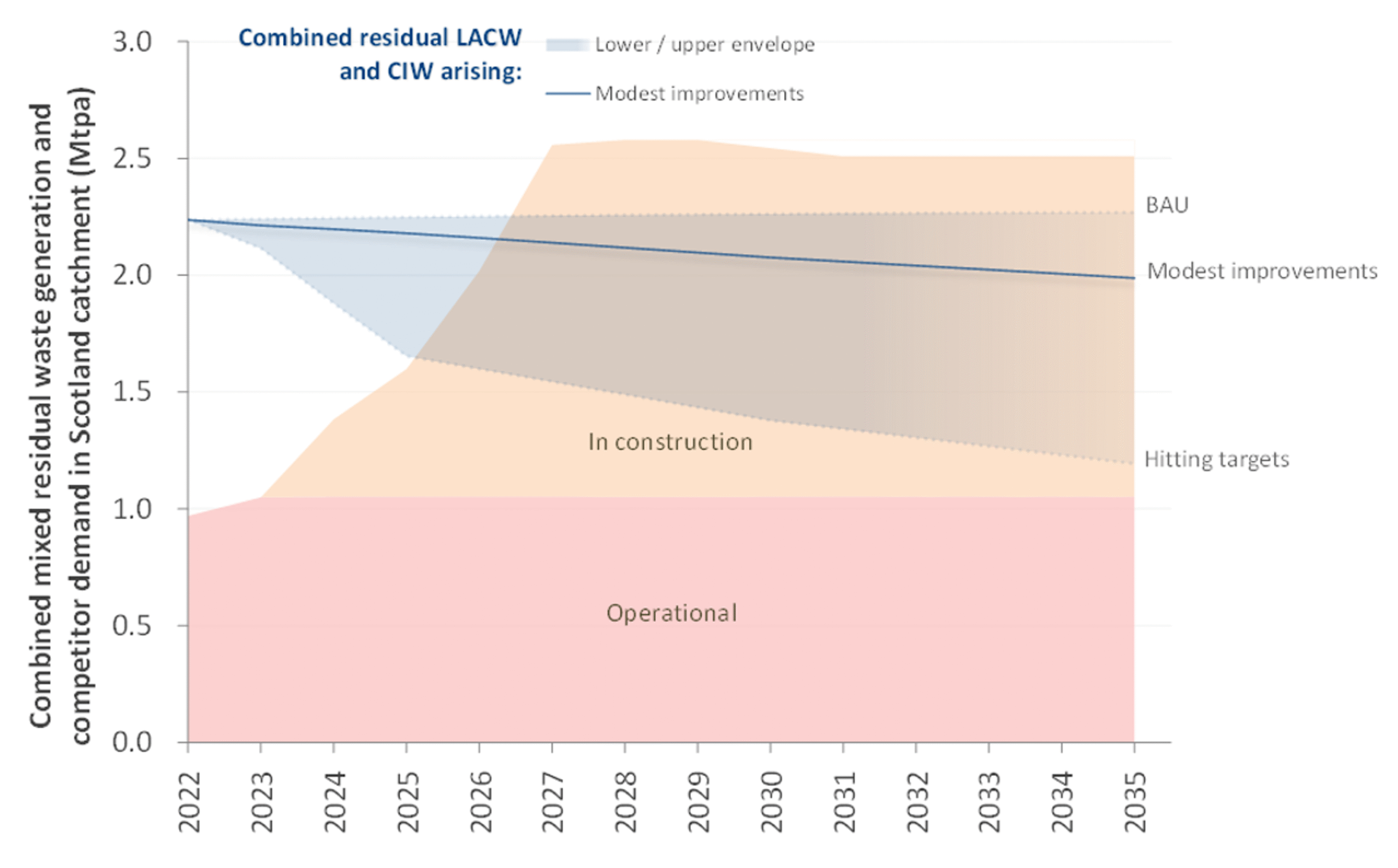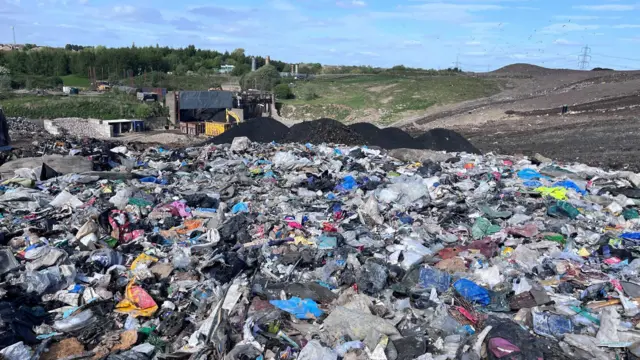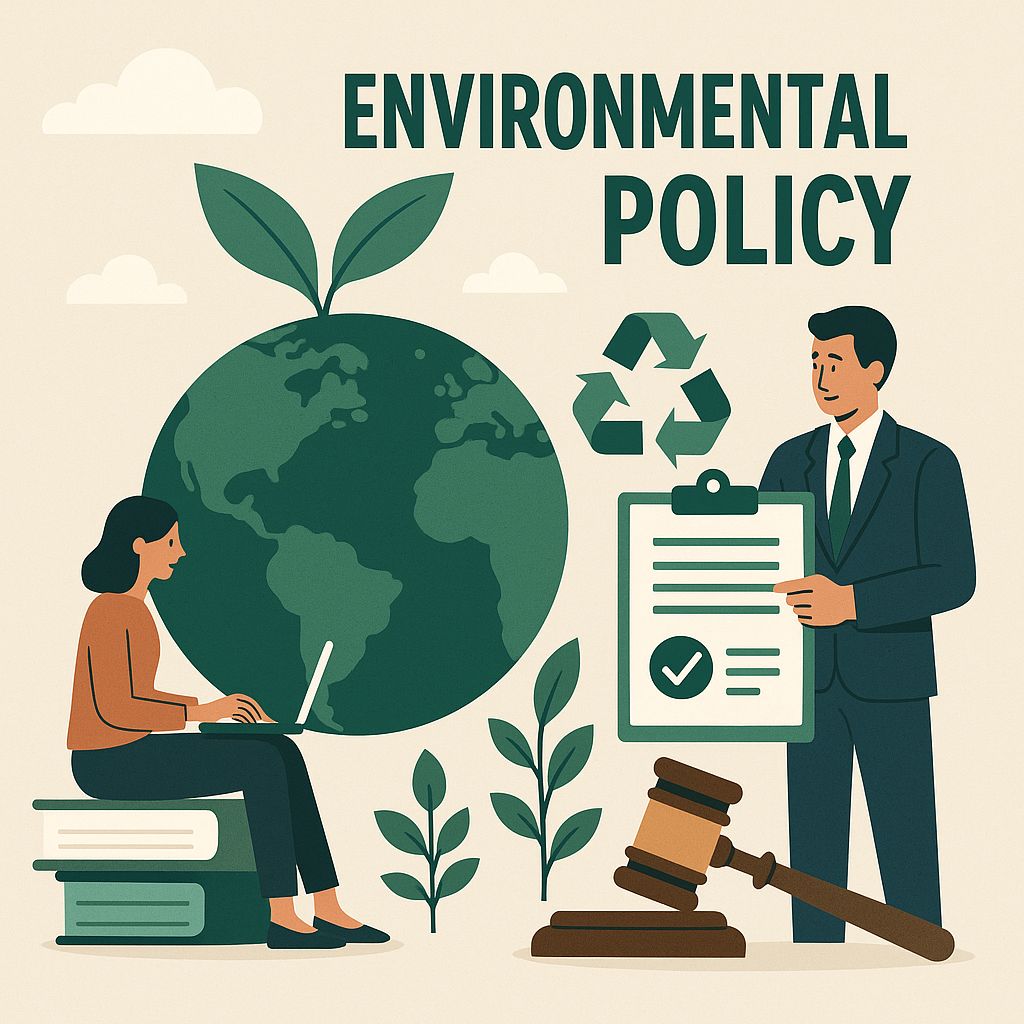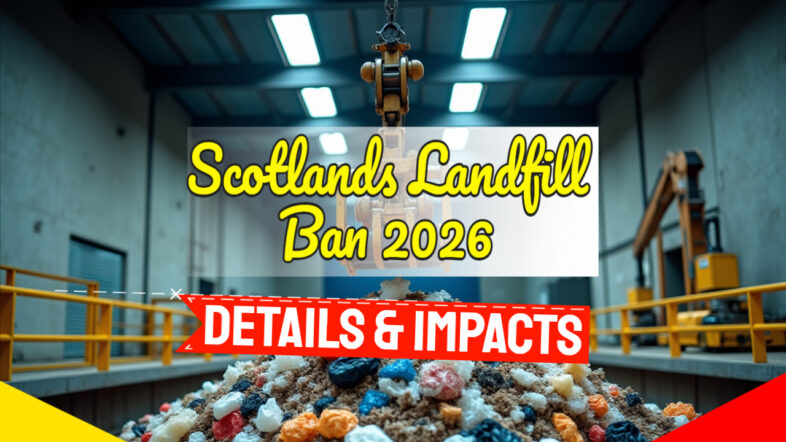Key Takeaways
- Scotland's landfill ban on biodegradable municipal waste takes effect January 1, 2026, as part of the nation's circular economy transition.
- There's a projected 600,000-tonne annual capacity gap at the outset of the ban, requiring significant infrastructure development and waste export arrangements.
- The ban aims to reduce greenhouse gas emissions from landfills and help Scotland meet its ambitious climate targets.
- Households and businesses will face new recycling requirements and waste management practices to comply with the regulations.
- Five new Energy from Waste plants are under construction, but they won't fully meet disposal requirements until 2027-2028, creating a critical transition period.
Scotland stands at the precipice of a major waste management transformation. In just over a year, a groundbreaking environmental policy will reshape how the nation handles its waste. The countdown to January 1, 2026 has begun – when Scotland's ban on landfilling biodegradable municipal waste officially takes effect.
This decisive move by the Scottish Government represents one of the most ambitious waste policy changes in the UK, forming a cornerstone of Scotland's transition toward a circular economy. The policy aims to dramatically reduce greenhouse gas emissions from landfills while encouraging better resource management. With the climate crisis demanding urgent action, Scotland's approach offers valuable lessons for environmental advocates worldwide.
Recent analysis conducted by SLR Consulting for Zero Waste Scotland reveals both progress and significant challenges ahead of the implementation deadline. While infrastructure development is underway, a substantial capacity gap remains that must be addressed to ensure a smooth transition. Understanding these challenges is crucial for everyone from policymakers to ordinary citizens as we collectively adapt to this new waste management paradigm.

“Scotland for the 2026 landfill ban …” from www.slrconsulting.com and used with no modifications.
Article-at-a-Glance
Scotland's 2026 landfill ban represents a pivotal shift in the nation's waste management strategy, focusing specifically on biodegradable municipal waste (BMW). This comprehensive ban aims to eliminate the harmful environmental impacts of decomposing organic materials in landfills, particularly methane emissions that contribute significantly to climate change. The ban was legislated through amendments to the Landfill (Scotland) Regulations 2003 and forms part of Scotland's broader Zero Waste Plan and circular economy ambitions.
Scotland's Landfill Ban Is Coming: What You Need to Know Now
Beginning January 1, 2026, Scotland will enforce a complete ban on sending biodegradable municipal waste to landfill sites across the country. This ban was originally scheduled for 2021 but was delayed to allow more time for infrastructure development and implementation planning. The regulation specifically targets municipal waste that can break down biologically – including food waste, garden trimmings, paper, cardboard, and certain textiles – materials that produce harmful greenhouse gases when they decompose in oxygen-poor landfill environments. For more insights, explore the disadvantages of a zero waste approach and its impact on landfill usage.
The Scottish Environment Protection Agency (SEPA) will oversee enforcement of the ban, with waste producers, collectors, and disposal facilities all bearing responsibility for compliance. Recent assessments indicate significant challenges ahead – most notably an estimated 600,000-tonne annual capacity gap between the waste requiring alternative treatment and the available infrastructure at the time of implementation. This shortfall means immediate action is needed from both government and industry to prevent disruption when the ban takes effect.
Five new Energy from Waste (EfW) plants are currently under construction across Scotland, which should fully meet disposal requirements by 2027-2028. However, the timing creates a critical transition period in 2026 when alternative solutions, particularly increased waste exports to facilities in England and European countries, will be necessary to bridge the gap. This presents both challenges and opportunities for waste management companies, local authorities, and businesses across Scotland.
SLR Consulting's Key Finding (April 2024): “Sufficient new EfW capacity is currently being developed in Scotland (with five new EfW plants at construction) to fully meet the landfill ban bio-medical waste (BMW) disposal requirements by 2027 or 2028. However a substantial annual capacity gap (estimated as c.600kt) is forecast to remain at the outset of the landfill ban from January 2026 – based on SLR's ‘business as usual' (BAU) modelling projections.”
What the 2026 Landfill Ban Actually Means for You
The 2026 landfill ban will affect virtually everyone in Scotland – from individual households to large businesses and public institutions. For ordinary citizens, the most noticeable changes will likely involve modified waste collection systems, enhanced separation requirements, and potentially altered collection schedules. Local authorities across Scotland are already beginning to adjust their waste management services in preparation, though approaches vary by region based on existing infrastructure and local challenges. To understand how you can contribute, explore 10 ways to reduce, reuse, and recycle effectively.

“rubbish will be exported to England …” from www.bbc.com and used with no modifications.
Materials Banned from Landfills
Understanding exactly what constitutes “biodegradable municipal waste” is crucial for compliance. According to SEPA guidance, the ban covers any municipal waste capable of undergoing anaerobic or aerobic decomposition. This includes all food waste, garden waste, paper and cardboard products, natural textiles like cotton and wool, and any mixed waste containing these materials. The definition encompasses both household waste and similar commercial waste from businesses, schools, hospitals, and other organizations.
Who Must Comply with the Ban
- Households separating waste according to local collection systems
- Businesses producing any amount of biodegradable waste
- Waste collection companies and local authorities
- Waste treatment facilities including transfer stations
- Landfill operators who must reject non-compliant waste
Key Deadlines and Implementation Timeline
The path to full implementation of Scotland's landfill ban includes several key milestones. Originally scheduled to take effect in January 2021, the ban was postponed to give local authorities and waste management companies more time to develop necessary infrastructure and processes. The revised implementation date of January 1, 2026 is now firmly established, with no further delays anticipated. This gives stakeholders approximately one year to finalize their compliance strategies, including understanding landfill gate fees.
SEPA has already published guidance documents to help waste producers and handlers prepare for the ban. These resources explain testing methodologies to determine if waste qualifies as biodegradable municipal waste and outline available treatment alternatives. By mid-2025, all waste management facilities in Scotland must have updated their permits and operational procedures to align with the new requirements, while waste producers should have contracts in place for compliant disposal routes.
Why Scotland Is Banning Biodegradable Waste from Landfills
Scotland's decision to ban biodegradable municipal waste from landfills stems from compelling environmental and climate considerations. The decomposition of organic materials in the oxygen-deprived environment of landfills produces methane – a greenhouse gas approximately 25 times more potent than carbon dioxide in its warming effect over a 100-year period. By diverting these materials from landfills, Scotland aims to significantly reduce its greenhouse gas emissions and mitigate climate change impacts.
The ban also addresses the inefficiency of burying valuable resources that could be recycled, composted, or used to generate energy. By forcing alternative treatment methods, the policy promotes resource recovery and supports Scotland's transition to a circular economy where materials remain in productive use rather than becoming waste. This approach aligns with Scotland's broader Zero Waste Plan and its ambitious targets to recycle 70% of waste and send only 5% to landfill by 2025.
Environmental Impact of Landfilled Waste
The environmental consequences of landfilling biodegradable waste extend beyond just greenhouse gas emissions. Decomposing organic materials in landfills produce leachate – a liquid that can contain harmful pollutants and potentially contaminate groundwater and nearby water bodies if not properly managed. Landfills also consume valuable land resources, create nuisance impacts like odors and pests, and represent a permanent burden requiring long-term monitoring and management costs.
By implementing the landfill ban, Scotland expects to reduce its annual methane emissions by thousands of tonnes, making a significant contribution to meeting its climate targets. The policy is projected to help Scotland reduce its carbon footprint by approximately 450,000 tonnes of CO2 equivalent per year – comparable to taking nearly 100,000 cars off the road.
Scotland's Current Waste Crisis
Despite progress in recycling rates over the past decade, Scotland still sends substantial amounts of biodegradable waste to landfills. Recent data indicates that approximately 760,000 tonnes of biodegradable municipal waste were landfilled in Scotland in 2022. This represents a significant environmental burden and illustrates the scale of the challenge ahead as the 2026 deadline approaches.
The waste management sector in Scotland is currently experiencing a transition period, with ageing landfill infrastructure gradually closing while new treatment capacity is still being developed. This has created a situation where some regions face limited disposal options and rising costs. The landfill ban implementation will accelerate this transition, necessitating the rapid development of alternative waste treatment solutions to prevent potential disruption to essential waste services. For insights on the potential challenges, you can explore the disadvantages of zero waste strategies.

“Waste in the United Kingdom – Wikipedia” from en.wikipedia.org and used with no modifications.
How This Ban Helps Scotland Meet Climate Targets
Scotland has set some of the most ambitious climate targets globally, including achieving net-zero emissions of all greenhouse gases by 2045. The landfill ban represents a key policy mechanism to help reach these targets by tackling a significant source of methane emissions. By preventing biodegradable materials from entering landfills, Scotland can make meaningful progress toward its interim target of reducing emissions by 75% by 2030 (compared to 1990 levels).
The policy also complements other environmental initiatives such as the Circular Economy Bill and the deposit return scheme for beverage containers. Together, these measures create a comprehensive framework for transforming Scotland's relationship with materials and waste, shifting toward more sustainable consumption and production patterns that minimise environmental impacts while maximising resource value.

5 Ways the Landfill Ban Will Change Your Waste Management
1. Changes to Your Household Bin System
Many Scottish households will notice changes to their bin systems as local authorities adapt collection methods to comply with the landfill ban. Some areas may introduce new bin colours or additional containers to facilitate better waste separation at source. The traditional general waste bin may be replaced or supplemented with specialised containers for different material streams. In urban areas with space constraints, communal collection points might be enhanced or redesigned to accommodate more segregated waste streams, potentially using underground storage systems or smart bins that monitor fill levels.
2. New Recycling Requirements
The landfill ban will reinforce and expand existing recycling requirements for Scottish residents and businesses. You'll likely need to become more diligent about separating recyclable materials from general waste, with stricter enforcement of correct bin usage. Materials like paper, cardboard, plastic, metal, and glass will need to be clean and properly sorted to maximise their recycling potential. Some local authorities may implement verification measures such as clear bags for certain waste streams or spot checks of bin contents to ensure compliance, particularly in areas where contamination rates have historically been high.
3. Food Waste Collection Expansion
Food waste represents one of the most problematic components of biodegradable municipal waste, generating significant methane when landfilled. Under the 2026 landfill ban, food waste collection services will be expanded to cover virtually all areas of Scotland, including rural communities that may currently lack dedicated food waste collections. Households will receive kitchen caddies and liners for collecting food scraps, which will then be processed through anaerobic digestion or composting facilities rather than sent to landfill. This expansion requires substantial investment in collection vehicles, treatment infrastructure, and public education campaigns to ensure proper participation.
4. Potential Cost Implications
The infrastructure development necessary to support the landfill ban will inevitably impact waste management costs. Some of these costs may be passed on to households and businesses through adjusted waste collection charges or council tax rates. In the short term, particularly during the 2026-2028 period when there's an identified capacity gap, the need to export waste to alternative treatment facilities may result in higher disposal costs. However, the Scottish Government is working to minimise financial impacts on residents, and the long-term economic benefits of resource recovery and reduced environmental damage are expected to offset these initial investments.
Businesses that produce large quantities of biodegradable waste may face more significant cost increases, especially if they haven't already implemented separate collection systems for recyclable materials and food waste. Proactive companies that adapt early and find innovative ways to reduce their waste volume could gain competitive advantages and potentially lower their overall waste management costs compared to those that delay compliance measures until the deadline approaches. For more information on the upcoming changes, you can read about Scotland's landfill ban.
5. Waste Collection Schedule Adjustments
To accommodate the separate collection of different waste streams, many areas will see adjustments to collection schedules. General waste collections may become less frequent, while recycling and food waste collections could increase in frequency. These changes aim to encourage proper separation by making recycling services more convenient than residual waste disposal. Digital tools such as smartphone apps with collection reminders and waste sorting guides are being developed by many local authorities to help residents navigate these schedule changes and understand what goes where in the new system.
Current Infrastructure Challenges for the 2026 Ban
Energy from Waste Capacity Gap
The most significant challenge identified in Scotland's preparation for the landfill ban is the projected capacity gap for treating biodegradable waste. According to SLR Consulting's 2024 report, while five new Energy from Waste (EfW) plants are under construction across Scotland, they won't be sufficient to handle all diverted waste when the ban takes effect in January 2026. The report forecasts a substantial annual capacity gap of approximately 600,000 tonnes at the outset of the ban, based on “business as usual” projections. This shortfall represents a critical implementation risk that requires urgent attention from policymakers, waste management companies, and local authorities.
The EfW facilities currently being built should fully meet disposal requirements by 2027-2028, creating a challenging transition period of 1-2 years. During this time, alternative solutions will be essential to prevent non-compliance or disruption to waste services. The capacity gap also raises concerns about potential increases in illegal dumping if legitimate disposal routes become constrained or prohibitively expensive, highlighting the need for robust enforcement and monitoring mechanisms alongside infrastructure development.
RDF Export Requirements
To bridge the capacity gap in the initial years following the ban's implementation, Scotland will need to significantly increase its exports of refuse-derived fuel (RDF) to neighbouring markets. Currently, Scotland exports less than 100,000 tonnes of RDF annually to facilities in England, Denmark, and Sweden. According to the SLR report, these exports will need to be “substantially increased via short-term contracts” to manage the transition period before domestic infrastructure catches up with demand. This approach depends on available capacity in receiving markets and may be affected by transport costs, regulatory requirements for waste shipments, and potential policy changes in destination countries. For those interested in sustainable practices, exploring ways to reduce, reuse, and recycle can provide additional insights.
Local Authority Readiness Status
The readiness of Scotland's 32 local authorities to implement the landfill ban varies considerably across the country. Urban areas generally have more advanced preparation due to better access to alternative treatment facilities and higher population densities that make specialised collection services more economically viable. Rural and island communities face greater challenges in establishing compliant waste management systems due to geographic isolation, smaller waste volumes, and higher transportation costs. The Scottish Government and Zero Waste Scotland are providing targeted support to these vulnerable areas, including funding for feasibility studies, infrastructure development, and collaborative regional solutions that pool resources across neighbouring authorities.
How to Prepare Your Home or Business Today
Improving Your Recycling Practices
Don't wait until 2026 to improve your waste separation habits. Start now by familiarising yourself with your local recycling guidelines and ensuring you're correctly sorting waste at source. Set up convenient recycling stations in your home or business with clearly labelled containers for different materials. Pay particular attention to paper, cardboard, and food waste – key biodegradable materials targeted by the ban. Train family members or employees on proper recycling practices, and regularly check for contamination issues that could prevent materials from being successfully recycled.
Food Waste Reduction Strategies
Reducing food waste at source is the most environmentally beneficial approach to managing this problematic waste stream. Implement meal planning and careful shopping practices to buy only what you need. Store food properly to maximise shelf life, and get creative with leftovers instead of discarding them. Businesses in the food sector should conduct regular waste audits to identify patterns of waste generation and opportunities for reduction. Consider composting suitable food waste at home if you have garden space, or support community composting initiatives in your area. For businesses, exploring partnerships with food redistribution charities can help ensure edible surplus food reaches people in need rather than becoming waste.
Finding Alternative Disposal Routes
For waste that cannot be reduced or recycled, start investigating alternative disposal routes now. Research local composting facilities, anaerobic digestion plants, or energy recovery options that can accept biodegradable waste. Businesses generating significant volumes of specific waste streams might find direct arrangements with specialised treatment facilities more cost-effective than generic waste collection services. Some materials, like clean wood waste, might find secondary markets as raw materials for manufacturing, while certain food wastes could be used in animal feed production, subject to relevant regulations.
Consider joining or forming waste exchange networks where one organisation's waste becomes another's resource. These industrial symbiosis approaches can often find value in materials that would otherwise require costly disposal. For household items like furniture or textiles, explore reuse organisations, repair cafes, or upcycling initiatives that can extend product lifespans and keep materials out of the waste stream altogether.
Working with Compliant Waste Carriers
As the landfill ban approaches, it's increasingly important to ensure your waste is handled by reputable, compliant carriers. Check that any waste management company you use is properly registered with SEPA and has a clear strategy for managing biodegradable waste after the ban takes effect. Ask prospective waste contractors about their disposal routes and treatment methods, requesting evidence that your waste won't end up in a landfill. For businesses, consider including landfill ban compliance requirements in your waste management contracts, with verification procedures to ensure your environmental obligations are being met throughout the waste management chain. Explore zero waste disposal methods to enhance your compliance efforts.
What Happens After 2026: The Future of Scottish Waste
The 2026 landfill ban represents not an endpoint but a milestone in Scotland's waste transformation journey. Beyond 2026, we can expect continued evolution toward truly circular systems where waste is designed out and materials maintain their highest value. The ban will accelerate innovation in recycling technologies, particularly for currently difficult-to-recycle materials. We'll likely see greater emphasis on product redesign to enhance recyclability, expanded producer responsibility for end-of-life management, and development of more localised treatment solutions to reduce transportation impacts. The experience gained during the ban's implementation will inform future policy development, potentially leading to extensions of landfill restrictions to additional waste streams or tightening of recycling requirements for specific materials.
Frequently Asked Questions
The approaching landfill ban has generated numerous questions from residents, businesses, and waste management professionals across Scotland. Below are answers to some of the most common queries about this significant policy change and its practical implications for different stakeholders.
Will the landfill ban increase my waste collection costs?
Some increase in waste management costs is likely, especially during the initial implementation phase when alternative treatment infrastructure is still being developed. The extent of cost increases will vary by location, with areas further from treatment facilities potentially facing higher transportation costs. However, the Scottish Government is working to minimise financial impacts through strategic infrastructure investment and phased implementation approaches.
For businesses, cost implications will largely depend on how well you adapt your waste management practices. Companies that proactively reduce waste generation, maximise recycling, and secure compliant disposal contracts ahead of time may mitigate potential cost increases. Some businesses might actually find overall cost savings through improved resource efficiency and waste reduction strategies implemented in response to the ban.
What happens if businesses don't comply with the landfill ban?
Non-compliance with the landfill ban could result in significant consequences under Scotland's environmental regulations. SEPA will be responsible for enforcement and has various powers, including the ability to issue fixed penalty notices, compliance notices, or, in severe cases, pursue criminal prosecution. Businesses found sending biodegradable waste to landfills after January 1, 2026, could face substantial fines, reputational damage, and potential disruption to their waste management services.
Can I still use my regular bins after the ban comes into effect?
Most households will continue using their existing bin systems, but how these bins are used and what goes in them may change. Your local authority might provide additional containers for specific waste streams or modify collection frequencies to prioritise recyclables and food waste over general waste. The key change will be ensuring that biodegradable materials are not placed in bins destined for landfill.
Some areas may implement entirely new bin systems with different colours or configurations to better facilitate waste separation. Local authorities will communicate any changes well in advance, typically providing guidance materials, online resources, and sometimes in-person information sessions to help residents adapt to new requirements.
What alternatives exist for biodegradable waste disposal?
Scotland is developing a diverse range of alternatives to landfill for biodegradable waste. These include anaerobic digestion facilities that convert food waste into biogas and fertilizer, in-vessel composting systems for garden and food waste, mechanical biological treatment plants that separate recyclables and process organic fractions, and energy-from-waste facilities that generate electricity and heat from non-recyclable materials. The most appropriate option depends on the specific waste type, with high-quality segregated materials generally directed to recycling or composting, while mixed residual waste typically goes to energy recovery.
How does Scotland's landfill ban compare to policies in other countries?
Scotland's approach aligns with progressive waste policies implemented in other European nations but represents one of the most comprehensive landfill restriction policies in the UK. Countries like Germany, Austria, and the Netherlands implemented similar landfill bans on untreated municipal waste years ago, demonstrating that such policies can successfully drive higher recycling rates and better resource management. However, Scotland's ban is being implemented within a shorter timeframe than many comparable international examples, creating both challenges and opportunities for rapid transformation.
Unlike some policies that focus solely on specific fractions like food waste, Scotland's ban encompasses all biodegradable municipal waste, making it particularly ambitious in scope. This comprehensive approach provides environmental benefits but requires more extensive changes to waste management systems than narrower restrictions. The Scottish ban also differs from some international examples by applying equally across all regions rather than allowing regional variations in implementation timelines.
As Scotland progresses toward the 2026 implementation deadline, the nation has a unique opportunity to demonstrate environmental leadership and establish a model for sustainable waste management that others can follow. The success of this policy will depend on continued collaboration between government, industry, and citizens, all working toward the shared goal of a cleaner, more circular future. To learn more about sustainable waste management solutions and how you can contribute to Scotland's environmental goals, visit SLR Consulting's insights on Scotland's landfill ban readiness.
Scotland is making strides towards a more sustainable future with its upcoming landfill ban set to take effect in 2026. This ambitious move aims to significantly reduce waste and promote recycling across the country. One of the key aspects of this initiative is the focus on encouraging the recycling of various materials, including plastics and electronics. For instance, there are numerous opportunities to make money recycling electronics, which not only supports the environment but also boosts the economy. As the ban approaches, businesses and individuals alike are urged to adapt to these changes and contribute to a greener Scotland.







